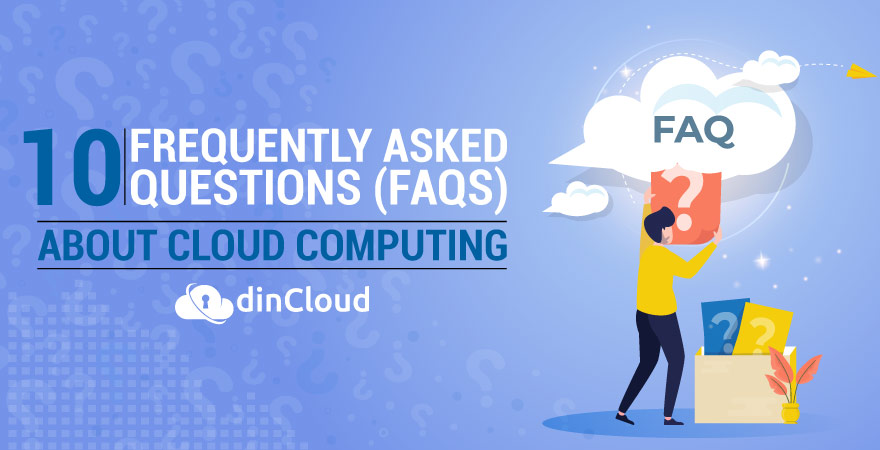Most material over the web about Cloud Computing is based on the presumption that the reader is already well versed with the cloud. While this may be true in most cases, it may not always be the case.

In this post, we will clarify some of the most frequent and fundamental questions people have about cloud computing.
How Can We Define Cloud Computing?
Cloud computing involves the delivery of resources such as storage, compute, network, software or applications from a centralized location. These services are delivered either over an organization’s internal dedicated network or the internet.
Also Read: 8 Benefits of Virtual Desktop Infrastructure (VDI)
What are the Basic Types of Cloud?
The types of cloud can be broken down into the following four broad categories: –
- Public Cloud
In this model, a third party Cloud Service Provider (CSP) like dinCloud provides resources such as storage, compute or network etc. to a large number of enterprises. The public cloud is based on the principle of shared or pooled resources.
- Private Cloud
In the case of private cloud, the deploying entity sets up an exclusive data center on premise, which then delivers the above resources. In some cases, a private cloud may also involve colocation to curtail the exorbitant hardware costs.
- Hybrid Cloud
A hybrid cloud is a combination of on premise and third party data centers. In hybrid cloud, workloads are systematically allocated to both the clouds based on certain considerations that revolve around cost, efficiency and regulatory compliance.
- Multi Cloud
The possibilities in case of multi cloud are limitless. This is a combination of both public and private cloud or the integration of multiple public cloud providers. This cloud model is difficult to integrate and manage, but also pays handsome dividends.
Also Read: Key Differentiators of dinCloud Hosted Virtual Desktops (dinHVD)
What are the Benefits of Cloud Computing?
- No need to procure and maintain on premise data centers
- Cloud services are compatible with multiple devices and operating systems
- You can enjoy instant scalability, thus improving organizational agility
- Cloud environments are generally more secure as compared to on premise ones
- Enterprise data is centralized, making it easy to secure it and maintain backups
- Accelerate the on-boarding time of employees, especially remote workers
What are the Things I Need to be Careful Of?
You need to factor in all the costs associated with a cloud service. You also need to compare these costs with other cloud providers and an on-premise model. Every feature or functionality you add to your cloud service may also entail additional costs.
Public cloud providers deliver more cost savings, but offer lesser control and flexibility. Whether your entity has the requisite human capital to initiate and manage a cloud deployment or migration to the cloud is another issue of paramount importance.
Also Read: Work from Home and Cloud Security Challenges
Is the Cloud a Secure Ecosystem?
Public Cloud Service Providers (CSP) like dinCloud adopt a multi layered approach to security. Measures such as firewalls, intrusion detection and prevention, encryption, user authentication, malware and ransomware protection fortify the security of cloud.
How Can I Develop a Cloud Strategy?
You will have to answer a fundamental question. Will I be adopting a cloud solution from scratch or migrating my existing workloads over to the cloud. How does the cloud align with the strategic goals of your enterprise is another important aspect of a cloud strategy.
Also Read: Desktop as a Service (DaaS) to Exhibit Strong Growth
How to Prepare my Entity for the Cloud?
Develop a clear cloud strategy with quantifiable goals. Ascertain the requisite capability of your IT professionals to undertake and manage the new cloud service. Would you need to improve the skillset of your existing IT professionals or engage new talent altogether.
Which Workloads Can I Shift to the Cloud?
In theory, any workload can be shifted over the cloud infrastructure. However, you will have to consider the impact of a cloud migration with special consideration to meeting all regulatory compliances where applicable.
Also Read: Importance of Web Scale IT in Cloud Computing
What is the Cost of Cloud?
The pricing of cloud services may be slightly complex. Leading CSP dinCloud eliminates this worry by offering a flat rate pricing model. You can also decrease the cost factor by entering into a long term Service Level Agreement (SLA) with your cloud provider.
Do I Need to Train My Own IT Staff?
In most cases, you will have to acclimatize your existing IT staff with the newly adopted cloud environment. The areas which need special attention include configuration, integration and understanding of the “shared responsibility model”.
Conclusion
Cloud computing is a vast and constantly evolving domain. A well-planned transition to the cloud, coupled with selecting the right Cloud Service Provider (CSP) are very crucial to attaining the desired results.
If you have any further questions or clarifications about the cloud, feel free to Contact Us.


